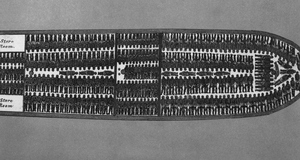Edgar Allan Poe and Race: Analyzing the "Absent Negro" Trope in Gothic Literature
By
2021, Vol. 13 No. 01 | pg. 1/1 AbstractEdgar Allan Poe is known for writing about a wide variety of controversial topics, such as death, murder, and addiction. However, one topic that his work tends to avoid is race and/or racism. Instead, he often chooses to include marginalized groups of people in tertiary roles, intentionally or unintentionally utilizing stereotypes associated with each marginalized subject to enhance or reveal insights on many of the more overt themes included in his literature. This paper will analyze Pompey, a side character in Poe’s “How to Write a Blackwood Article” in order to assess how his, as Toni Morrison would posit, “Africanist presence” adds meaning to Poe’s “Blackwood Article,” and how the depictions of Pompey reveal the fears of white beneficiaries of the hegemonic social and political class systems of the west during the 1800s. Moreover, this paper will analyze how, even in tertiary roles or in texts where the marginalized characters are excluded altogether, there is always evidence of the Africanist Presence, as American Literature, especially the American Gothic, is unable to escape the reality that is the racist, sexist, homophobic hegemonic socio-political system created to keep marginalized people in second-class or tertiary roles in real life. Edgar Allan Poe, one of the most studied nineteenth-century writers, was never afraid to tackle controversial or lofty topics, often discussing themes of grief, insanity, monomania, death, revenge, and incest. One topic that Poe’s stories never clearly address, however, is race. Though he did write about people of color, mostly in smaller, tertiary roles, none of their character arcs or roles seem meaningful enough to reveal any of his actual beliefs on the topic of race. Moreover, if other races happen to be included, specifically members of the Black community, his representations tend to be oversimplified or even stereotypical, often casting black people as simple slaves with little to no agency. This “absence” of race in Poe’s writing, along with many works of the nineteenth-century, results in the trope of the “absent negro,” the one whom, after a fatal or violent act upon a white counterpart, departs from the scene, never to be seen again, or one who never appears at all, save for a small “guest appearance” that is not significant enough to color (literally and figuratively) the text in a new light. Understanding Thing Theory may account for this absence. By identifying and analyzing the relationships between objects and people in Poe’s stories, some of these insights or opinions may become more apparent, potentially altering, reinforcing, or simply revealing many of the colonial-world anxieties hidden in Poe’s writing. This paper will analyze the “absent negro” trope in Poe’s writing, pushing race out of the margins in order to reveal Poe’s possible beliefs on the racial issues in antebellum America. I would first like to start by defining what I mean by “absent.” I do not mean to say that the presence of race or of the African-American is simply not there, physically, socially, or otherwise. What I am referring to, however, is the inconspicuous way in which race is handled in Poe’s writing—how it is only displayed through small, tertiary roles and how it is often abandoned altogether in the end. By presenting race in this way, Poe is able to underscore rather than diminish the importance of race in America, as “invisible things are not necessarily “not-there”; that a void may be empty, but is not a vacuum. In addition, certain absences are so stressed, so ornate, so planned, they call attention to themselves; arrest us with intentionality and purpose, like neighborhoods that are defined by the population held away from them” (Morrison 11).In Romancing the Shadow: Poe and Race, editor J. Gerald Kennedy states after discussing the unknown nature of Poe’s true beliefs as they relate to race: “The resilience of the misattribution [of Poe’s work] raises a number of important issues not only about Poe's racism but also about the peculiar function that the concept of racism plays in critical discourse today,” (11). Because of this, this paper will not focus on whether or not Poe was “racist”—besides, as Kennedy posits, there are multiple “racisms”—but on what his depictions of people of color, namely slaves or other representations of Black Americans, reveal. The best and clearest example of such a representation can be found in Poe’s story “How to Write a Blackwood Article,” which details a young female writer’s experience working for the sensationalist Blackwood Magazine and which features the “absent negro” trope that is commonly found in Poe’s writing. As expected, the “absent negro” trope doesn’t appear until the very end of the tale, after Zenobia has received instructions on how to mimic the Blackwood style, and, more importantly, after having been encouraged to “get into some immediate difficulty” (Poe 287) in order to inspire said article. In doing so, she brings along her “negro-servant Pompey” and her lap-dog, Diana. Interestingly enough, Poe—consciously or not—situates both Diana and Pompey in the place of a thing, stating just before Pompey and Diana’s descriptions:
This “prologue” literally causes the coming descriptions of Pompey and Diana to coincide with Farnell’s definition of the “thing” (which is different than the “Thing” with a capital T). It also situates Pompey in the “unnameable void at the centre of the Real” that “both resists and provokes symbolization” (Farnell 113). Farnell continues to write:
This “unnameability” of the Thing, as Farnell posits, often results in—or perhaps is caused by—the misrepresentation of the Thing. When dealing with race, this otherness is often misrepresented via stereotypes, as seen in the character of Pompey, Zenobia’s slave:
It is important to take note of the fact that Pompey, while maintaining many of the stereotypical representations of Black Americans (big lips, large ears, etc.), he is also described as a short, ugly little creature, almost resembling an elf or goblin, further distancing him from humanity and further likening him to the traditional idea of what, according to Brown, constitutes a “thing”:
Pompey’s description as a short, elflike creature resembles the description of a broken drill, of an object that cannot efficiently serve its purpose (especially considering that in the antebellum period, taller, stronger slaves were more “valuable”). Thus, Pompey is two-layers detached from humanity: firstly, because of his race, and secondly because of his usefulness, or lack thereof. He is the “othered other” a twice-removed symbol of all that is abject or meant to be discarded. His only usefulness as a character is completely based on his relationship to Psyche Zenobia, who literally uses him as his stepping stool by standing on his shoulders in order to pass her head through the aperture leading into the clock (Poe 292). Pompey’s entire existence, then, is entirely based on the subject/object dialectic identified by Brown’s “Thing Theory.” This is problematic in a number of ways, the most obvious being that a possible message being sent is that Pompey, the sole representation of the Black community in this story, is only of use to support his master, to propel her forward and upwards, and to be literally stepped on, thus further “thingifying” Pompey by reducing his entire existence to his usefulness, or lack thereof. Incidentally, as Kennedy posits, this, along with other descriptions of other races in Poe’s writing, has caused much debate and speculation surrounding Poe’s racial beliefs. However, when looking more deeply into the overarching situation Pompey faces in this story, readers can find that the answers to the questions surrounding Poe’s politics are not so simple. Another problem that arises in this story is Pompey’s clear hesitation to help Miss Zenobia at the risk of his own personal expense. One of the most obvious examples of Pompey’s quest for humanization occurs when, “after some minutes, [Zenobia] was aroused by the voice of Pompey, who declared he could stand it no longer, and requested that [she] would be so kind as to come down.” Zenobia responds by denying this request, citing it as “unreasonable,” and proceeds to tell him so “in a speech of some length” (Poe 293). Again and again, Pompey’s needs are denied and cited as “foolish” or “unreasonable,” (Poe 293) while Zenobia’s desires get satiated, despite how foolish or unreasonable they are. However, none of these instances are quite as heartbreaking as the moment when Miss Zenobia describes the following altercation with Pompey:
This interaction is especially problematic and serves the purpose of further distancing Pompey from his humanity due to the fact that this overcoat was his only protective—and “civilized”—layer of clothing:
Readers should also take note of the fact that Pompey is suggested to have stolen this overcoat, criminalizing him and pushing him either farther into the margins so that, at the end of the story, Pompey no longer represents a human being, but rather exemplifies what it means to be a “thing.” What this interaction also demonstrates, however, is the fragility of the “thing”—or the fragility of upholding this label. As previously stated, something is typically thingified when the subject/object relationship is altered, destroyed, or broken. Therefore, Pompey struggling to reclaim his identity, to hold onto his overcoat, and to resist Zenobia’s unjust demands are snippets of him fighting to reclaim his identity as a person, to distance himself from the label of “thing” and to somehow sever the subject/object relationship confining him to his ontological position as a “thing.” Pompey’s attempts to re-humanize himself is in its own right riddled with Western anxieties, since Pompey’s low status in life is the only thread keeping the hegemonic social system in place—a system that can only guarantee the social positioning of one group of people by excluding or oppressing the status of another. To devalue someone, they must be made into a “thing,” but if the thing resists such a classification, the entire ecosystem is certain to collapse. Incidentally, his “otherness” is misrepresented in a plethora of ways, from his physical appearance to his actions, but another aspect of Pompey’s personality to recognize is his name. Pompey’s alterity is reinforced through his name, which not only distances him from the white, Eurocentric standards of the west, but with other members of the Black community. It is no surprise that Poe is extremely intentional when naming his characters, often using names that either describe the character entirely (for example, Prince Prospero in “The Masque of the Red Death) or that function ironically (like Fortunado from “The Cask of Amontillado). In this case, the name Pompey contains a double entendre: Pompey, also known as Pompey the Great, was the leading Roman general who played a significant role in Rome’s transformation from a republic to an empire and who was a political ally and later an enemy of Julius Caesar; and Pompeii, a volcano that, once erupted, was buried under tons of volcanic ash—and, consequently, has been used as an insult or slur against Black Americans who were considered “dirty” or “ashy.” This name situates Pompey as an enemy and as a member of the lowest class—as a thread to this extremely delicate ecosystem—which distances him from not just his white counterparts, but from his black counterparts as well. The duality of Pompey’s name, then, reinforces the “absent negro” stereotype in the sense that it achieves what it suggests: the downfall of the current state of affairs. When re-examining the meaning of the name “Pompey” via a historical framework, what first comes to mind is obviously the fact that Pompey played a major role in Rome’s transformation from a Republic to an Empire: from a political structure where citizens vote for an individual to represent them in governmental processes, rather than attending and voting themselves, to a monarchy, where the “Emperor” rules over very large territories with total control. When examining these political structures through the lens of race, the colonial fears of the “overthrown oppressor” via the exacted revenge of the “other” becomes extremely apparent. In this case, the imperialist regime is structural racism, which can only function by enacting total dominance over a group of people. Edward Said describes this process in Culture and Imperialism, when he states:
Moreover, it is important to note that, within the “absent negro” trope, the black subject is often the sole survivor of his or her master or oppressor’s—self-inflicted or otherwise—act of violence. In this case, Pompey, the sole survivor of Zenobia’s Blackwood article quest, gains a newfound freedom after the downfall of his oppressor. When describing the inner-workings of an Imperialist society in Culture and Imperialism, Said posits that the “circularity, the perfect closure of the whole thing is not only aesthetically but also mentally unassailable” (Said 24). Said also states that “[a marginalized subject’s] self-consciousness as an outsider can allow [them] actively to comprehend how the machine works, given that you and it are fundamentally not in perfect synchrony or correspondence” (Said 25). This scenario also opens up the possibility of retaliation—the drill attacking the worker, the oppressed overtaking the oppressor. Said posits that there is “no way out of the sovereign historical force of imperialism, and that it has the power of a system representing as well as speaking for everything within its dominion” (Said 24), thereby leaving us with the assumption that, if escape is impossible, only subversion is viable. Moreover, when returning to the “absent negro” scene, the first question that comes to mind is “Where did [Pompey] go?” and if not that, this unfortunate scene leaves us to ask: “what will he do?” Pompey’s untold post-“Predicament” story, then, unveils a plethora of Western anxieties pertaining specifically to the state of race relations in the United States. Whether Poe meant to reveal these anxieties or not, whether these are a reflection of his own beliefs, or whether he was simply mimicking the trope commonly used before him, this fear remains at the heart of Pompey’s journey. It also remains at the heart of America’s journey, detailing the postcolonial fear of being overturned or insurrected by those meant to be marginalized. Said’s Culture and Imperialism raises an excellent point: that there is, in fact, no way out of the force of imperialism, and that in order for this system to remain balanced and maintain its power, it necessitates the absolute subordination of everything within its domain. In this case, a white, consumerist, Eurocentric, male-centered America can only remain in tact if every race, gender, and class below the designated rulers of the imperialist regime remain subordinated, taking the place of the “thing.” Morrison discusses this system in Romancing the Shadow when she states:
The “absent negro” trope commonly found in Romantic and Gothic literature, then, serves—depending on which lenses are used to observe such a phenomenon—as both a warning and a ray of hope: for those on the top of the imperialist regime, it may serve as a warning to keep everyone else in their subordinated place, as many of those in power firmly believe (albeit falsely) that there is no room at the top of the totem pole, and that granting others—namely members of the black community—access to equal resources will somehow deny them of theirs (a viewpoint that continues to be held today). However, for those at the bottom of the totem pole, for those constantly being governed over by an oppressive or unfair regime, it shines a light of hope that there is a chance of escape, and that one day, the very forces working against them will collapse internally, resulting in a newfound freedom and a brand new identity that is not dependent on one’s usefulness or interconnectivity to a massively flawed system. By observing the “absent negro” trope in literature, then, specifically as it is used in Poe’s writing, many of these western fears come into fruition, highlighting the social issues pertaining to marginalization and human rights that some writers may have attempted to ignore. By analyzing this trope, this “Africanist presence” as Morrison posits, “informs in compelling and inescapable ways the texture of American literature. It is a dark and abiding presence, there for literary imagination as both a visible and an invisible mediating force” (Morrison, “Romancing the Shadow” 46). Pompey’s departure at the end of “How to Write a Blackwood Article,” is not there to suggest that America is “raceless” or that American literature could ever escape the Black ghost haunting the text, but to suggest that, even in “race-free” literature, Pompey’s overcoat remains. ReferencesArvatov, Boris, and Christina Kiaer. “Everyday Life and the Culture of the Thing (Toward the Formulation of the Question).” October, vol. 81, 1997, p. 119., doi:10.2307/779022. Brown, Bill. “Thing Theory.” Critical Inquiry, The University of Chicago Press, www.journals.uchicago.edu/doi/10.1086/449030. Farnell, Gary. “The Gothic and the Thing.” University of Winchester, www.winchester.ac.uk/about-us/leadership-and-governance/staff-directory/staff-profiles/farnell.php. “How to Write a Blackwood Article.” Edgar Allan Poe Poetry, Tales, and Selected Essays, by Edgar Allan. Poe, The Library of America College Editions, 1984, pp. 278–297. Kennedy, J.Gerald, and Liliane Weissberg. Romancing the Shadow : Poe and Race. Oxford University Press, 2001. Morrison, Toni, et al. Unspeakable Things Unspoken: the Afro-American Presence in American Literature. University of Michigan, 1989. Morrison, Toni. “Two: Romancing the Shadow.” Playing in the Dark: Whiteness and the Literary Imagination, by Toni Morrison, Vintage Books, a Division of Random House, Inc, 2019, pp. 29–59. Said, Edward W. Culture and Imperialism. Vintage Digital, 2014.
Suggested Reading from Inquiries Journal
Inquiries Journal provides undergraduate and graduate students around the world a platform for the wide dissemination of academic work over a range of core disciplines. Representing the work of students from hundreds of institutions around the globe, Inquiries Journal's large database of academic articles is completely free. Learn more | Blog | Submit Latest in Literature |


















